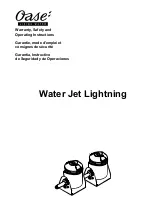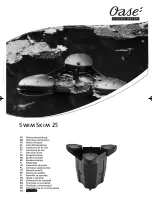
8
D10-991-2400 5/1/04
D/G-10 Installation
Before Initial Start-Up
Before you start the pump, be sure that:
•
All shutoff valves are open, and the pump has an adequate
supply of fluid.
•
All connections are tight.
•
The oil level is 1/4 in. (6 mm) above the cast surface in the
upper oil reservoir.
•
The relief valve on the pump outlet is adjusted so the pump
starts under minimum pressure.
•
All pulleys and belts are properly aligned, and belts are
tensioned according to specification.
•
All pulleys, belts and shaft couplings have adequate safety
guards.
Initial Start-Up Procedure
1. Turn on power to the pump motor.
2. Check the inlet pressure or vacuum. To maintain maximum
flow, inlet vacuum must not exceed 7 in. Hg at 70
°
F (180
mm Hg at 21
°
C). Inlet pressure must not exceed 250 psi
(17 bar).
3. Listen for any erratic noise, and look for unsteady flow. If
the pump does not clear, refer to the Troubleshooting
Section.
4. If the system has an air lock and the pump fails to prime:
a. Turn off the power.
b. Remove the pressure gauge or plug from the tee fitting
at the pump outlet (refer to the illustration on page 5).
NOTE: Fluid may come out of this port when the plug
is removed. Provide an adequate catch basin for fluid
spillage, if required. Fluid will come out of this port when
the pump is started, so we recommend that you attach
adequate plumbing from this port so fluid will not be
sprayed or lost. Use high-pressure-rated hose and
fittings from this port. Take all safety precautions to
assure safe handling of the fluid being pumped.
c. Jog the system on and off until the fluid coming from this
port is air-free.
d. Turn off the power.
e. Remove the plumbing that was temporarily installed, and
reinstall the pressure gauge or plug.
5. Adjust the discharge pressure regulator to the desired
operating and bypass pressures. Do not exceed the
maximum pressure rating of the pump.
6. After the pressure regulator is adjusted, set the safety relief
valve at 100 psi (7 bar) higher than the desired operating
pressure. To verify this setting, adjust the discharge pressure
regulator upward until the relief valve opens. Follow the
recommendations in the above NOTE (step 4b) for handling
the fluid that will come from the relief valve.
7. Reset the discharge pressure regulator to the desired system
pressure.
8. Provide a return line from the relief valve to the supply tank,
similar to the bypass line from the pressure regulator.






































